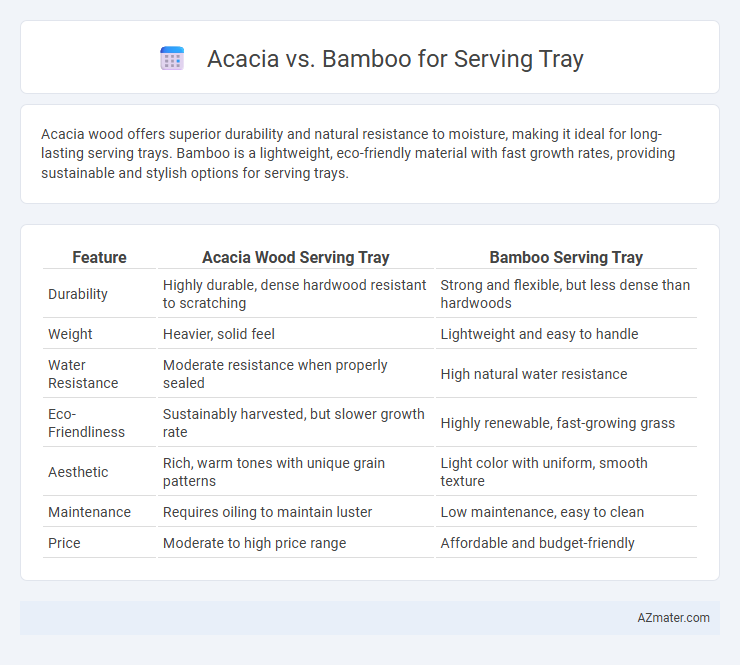Acacia wood offers superior durability and natural resistance to moisture, making it ideal for long-lasting serving trays. Bamboo is a lightweight, eco-friendly material with fast growth rates, providing sustainable and stylish options for serving trays.
Table of Comparison
| Feature | Acacia Wood Serving Tray | Bamboo Serving Tray |
|---|---|---|
| Durability | Highly durable, dense hardwood resistant to scratching | Strong and flexible, but less dense than hardwoods |
| Weight | Heavier, solid feel | Lightweight and easy to handle |
| Water Resistance | Moderate resistance when properly sealed | High natural water resistance |
| Eco-Friendliness | Sustainably harvested, but slower growth rate | Highly renewable, fast-growing grass |
| Aesthetic | Rich, warm tones with unique grain patterns | Light color with uniform, smooth texture |
| Maintenance | Requires oiling to maintain luster | Low maintenance, easy to clean |
| Price | Moderate to high price range | Affordable and budget-friendly |
Introduction to Acacia and Bamboo Serving Trays
Acacia serving trays offer durability and a rich, natural grain that resists scratches and moisture, making them ideal for long-term use. Bamboo serving trays provide a lightweight option with fast renewable growth and natural antibacterial properties, contributing to eco-friendly kitchenware. Both materials enhance serving aesthetics with unique textures, yet Acacia's hardwood strength contrasts with Bamboo's flexibility and sustainability.
Material Origins: Acacia vs Bamboo
Acacia wood, derived from hardwood trees native to Australia and Africa, offers durability and a rich, natural grain that enhances serving trays with a sturdy, elegant finish. Bamboo, a fast-growing grass predominantly found in Asia, provides a lightweight, eco-friendly alternative with high tensile strength and a smooth texture ideal for sustainable kitchenware. Both materials bring distinct origins and environmental benefits, with acacia emphasizing traditional hardwood resilience and bamboo showcasing renewable rapid growth.
Durability and Strength Comparison
Acacia wood offers exceptional durability with its dense grain, making it resistant to scratches and moisture, ideal for long-lasting serving trays. Bamboo provides impressive strength due to its fibrous structure, offering lightweight yet sturdy support that resists warping and cracking. When comparing Acacia vs Bamboo for serving trays, Acacia generally withstands heavy use better, while Bamboo excels in flexibility and eco-friendly renewability.
Aesthetic Appeal and Design Options
Acacia wood offers a rich, warm tone with intricate natural grain patterns, making each serving tray unique and elegant, while bamboo provides a lighter, more uniform look with a contemporary feel ideal for minimalist designs. Acacia's deeper hues and organic texture suit rustic or classic aesthetics, whereas bamboo's smooth, sleek surface supports modern and eco-friendly decor themes. Both materials enable varied design options, but acacia often allows for more intricate carvings and finishes, contrasting with bamboo's clean lines and environmentally sustainable appeal.
Environmental Impact and Sustainability
Acacia wood is a fast-growing, renewable resource known for its durability and resistance to water, making it an eco-friendly option for serving trays. Bamboo is one of the fastest-growing plants globally, capable of reaching maturity in 3-5 years, and is highly sustainable due to its rapid replenishment and minimal pesticide use. Both materials offer biodegradable, low-waste solutions, but bamboo's quicker growth cycle and higher carbon sequestration make it a slightly more sustainable choice for environmentally conscious consumers.
Maintenance and Care Requirements
Acacia serving trays require regular oiling with mineral or food-safe oils to maintain their natural luster and prevent cracking, while bamboo trays benefit from a gentle wipe with a damp cloth and occasional application of a light oil to avoid dryness. Both materials should be kept away from prolonged soaking and extreme heat to preserve their structural integrity and appearance. Proper maintenance ensures longevity, with acacia demanding slightly more frequent conditioning compared to the relatively low-maintenance bamboo trays.
Weight and Handling Differences
Acacia serving trays are generally heavier due to the dense hardwood composition, providing a sturdy feel but requiring more effort to carry and handle. Bamboo trays are notably lighter, offering increased ease of handling and maneuverability, ideal for frequent serving or casual use. The weight difference impacts balance and grip, with bamboo allowing for quicker, less strenuous serving tasks compared to acacia's robust, weightier presence.
Pricing and Value for Money
Acacia serving trays generally offer a balance of durability and aesthetic appeal at a moderate price point, making them a cost-effective choice for everyday use. Bamboo trays are often more affordable due to faster growth cycles and sustainability, providing great value for eco-conscious buyers seeking lightweight and sturdy options. When comparing pricing and value for money, bamboo excels in budget-friendly durability, while acacia delivers higher-end craftsmanship and longevity.
Popular Uses and Versatility
Acacia wood is prized for its natural durability and rich, warm tones, making it ideal for serving trays that complement rustic and elegant table settings. Bamboo offers lightweight strength and a smooth, eco-friendly surface ideal for modern, minimalist serving trays that resist moisture and stains. Both materials provide versatile design options for serving trays, with acacia excelling in aesthetic warmth and bamboo favored for sustainability and ease of maintenance.
Which is Better: Acacia or Bamboo Serving Tray?
Acacia serving trays are prized for their rich, natural grain patterns and durability, often resistant to scratches and water damage, making them ideal for both aesthetic appeal and longevity. Bamboo trays offer a lightweight, eco-friendly option with high water resistance and natural antimicrobial properties, suitable for sustainable living and easy handling. Choosing between acacia and bamboo depends on prioritizing hardness and visual warmth versus sustainability and anti-microbial features in a serving tray.

Infographic: Acacia vs Bamboo for Serving Tray
 azmater.com
azmater.com